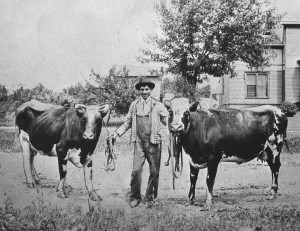In 1898, the village’s first electricity generating plant was built at 47th and Central. And, to help run it, they chose 24-year-old Lawrence Castrodale.

Lawrence Castrodale, first village electrician – circa 1899
People were amazed in 1893 when they got their first glimpse of electric lighting at the World’s Columbian Exposition. So, by 1898, Western Springs decided to take a major step forward by installing its own electric generator for the then-significant sum of $3,460. It would be located at the village pump house on 47th Street, near Central Avenue. To help run it and install electric lines to each residence, the village hired the young man shown in the photo.
Lawrence Castrodale was not a farmer. The cows he was tending were simply those of a neighbor. In the 1890s, many villagers still kept livestock for their personal needs. By all accounts, Castrodale was a quick learner. He not only installed the residential electric service. but street lights as well. Soon afterward, he opened a small appliance and repair shop near the Water Tower. Ads from that period show vacuum cleaners selling for $35, Christmas tree lights (a 32-light-string for $10), and washing machines for $30. And, starting in 1900, he was hired to also install telephone lines in the village.
Castrodale went on to pursue a successful career with the International Time Recording Company, a predecessor of the IBM Corporation. But, the village’s electric venture was not as fortunate. Outages were not uncommon. And, due to its high cost of operation, the plant was used primarily for night-time lighting. One exception was each Monday when the power was on during part of the day to serve those with electric washing machines. While this gradually expanded to three half-days a week, residents were still not satisfied. In 1919, petitions began circulating that demanded electricity all day long, every day of the week.
The village soon recognized that the cost to modernize and expand its electric generating capacity was simply too expensive. As a result, by 1924, the village had shut down its own electric plant and connected its lines to the Public Service Company, which eventually became Commonwealth Edison. So, for the first time, residents had power 24-hours-a-day, seven days a week. And, as a bonus, all power poles were removed from parkways and placed behind the homes. So, the next time you turn on a light or that flat screen television, think of those early residents and how far we’ve progressed.
